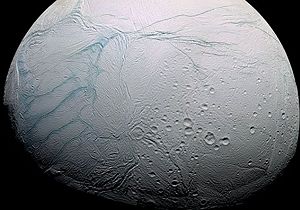Enceladus: Difference between revisions
Jump to navigation
Jump to search


imported>John Stephenson (Pronunciation) |
imported>Subpagination Bot m (Add {{subpages}} and remove any categories (details)) |
||
| Line 1: | Line 1: | ||
{{subpages}} | |||
[[Image:Enceladusstripes_strip2.jpg|right|thumb|300px|[[Enceladus]], one of [[Saturn]]'s many moons, could be volcanically active and possibly home to other [[life]].{{PD-image|Science@NASA}}]] | [[Image:Enceladusstripes_strip2.jpg|right|thumb|300px|[[Enceladus]], one of [[Saturn]]'s many moons, could be volcanically active and possibly home to other [[life]].{{PD-image|Science@NASA}}]] | ||
'''Enceladus'''<ref>Pronounced [ɛnˈsɛlədəs].</ref> is the sixth-largest [[natural satellite|moon]] of [[Saturn]]. It was discovered in 1789 by [[William Herschel]]. The moon is notable as a candidate for harbouring extra-terrestrial [[life]]. | '''Enceladus'''<ref>Pronounced [ɛnˈsɛlədəs].</ref> is the sixth-largest [[natural satellite|moon]] of [[Saturn]]. It was discovered in 1789 by [[William Herschel]]. The moon is notable as a candidate for harbouring extra-terrestrial [[life]]. | ||
| Line 15: | Line 17: | ||
==See also== | ==See also== | ||
*[[Saturn]] | *[[Saturn]] | ||
Revision as of 12:39, 27 January 2008

Enceladus, one of Saturn's many moons, could be volcanically active and possibly home to other life.Template:PD-image
Enceladus[1] is the sixth-largest moon of Saturn. It was discovered in 1789 by William Herschel. The moon is notable as a candidate for harbouring extra-terrestrial life.
It has recently been suggested that Enceladus might be volcanically active - this could explain the icy geysers in its southern region, first observed in 2005 by the Cassini probe. If it is true that the little moon is spewing water into space,[2] Enceladus would be added to the growing list of places in the solar system that might be home to some form of life. To try to resolve these matters, Cassini is on course for a return visit to Enceladus, timed for March 2008.[3]
Footnotes
- ↑ Pronounced [ɛnˈsɛlədəs].
- ↑ Science@NASA: 'Radical! Liquid Water on Enceladus'. 3rd September 2006.
- ↑ New Scientist: 'Geyser teaser: the moon that should be colder'. 25th August 2007. Requires subscription for the full article.
External links
- Cassini-Huygens Home - official website covering this joint NASA/ESA/ASI mission
- Multimedia - Images -Moons - Enceladus - Cassini photos of Enceladus, with NASA information